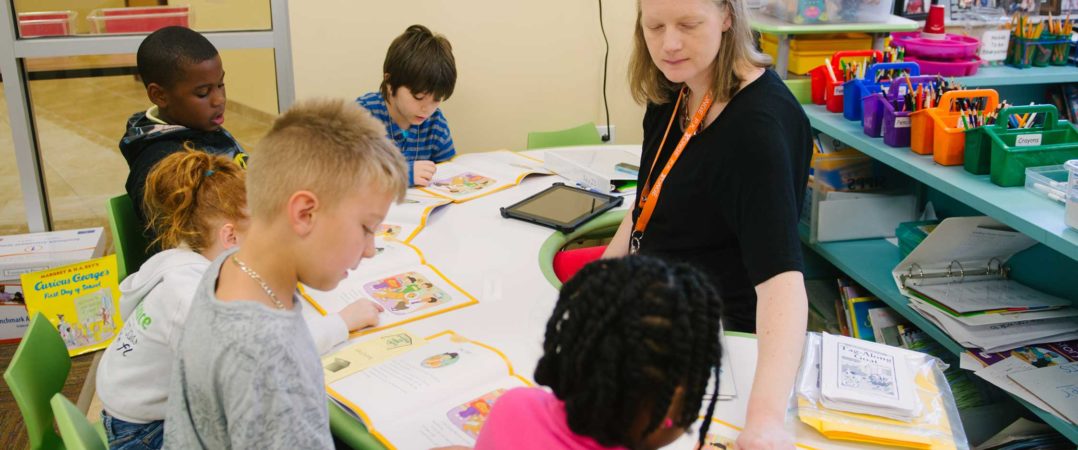What is dyslexia? If you are new to teaching reading, you may be wondering why there is so much interest in dyslexia and what it may mean for you as an educator. Let’s dig into those questions, but first, let’s find out more about what dyslexia is and what it is not.
What is dyslexia?
Dyslexia is extremely common. Estimates of the portion of the population that has dyslexia range from 1 in 20 to 1 in 5. The differences in these estimates stem from differences in how dyslexia is understood and defined.
Chances are, when you hear the word dyslexia, the first thing you think of is reversals—seeing letters or words backward (e.g., b for d, saw for was). It may be a surprise to learn that reversals are NOT a symptom of dyslexia. This is just one of many widely believed myths about dyslexia.
Nearly all children make reversals at some point early in their literacy development. We can, therefore, think of reversals as simply an indicator of an early stage of literacy development.
Because children with dyslexia generally take longer to learn to read, they may make reversals longer than other children, but it is not because they see letters or words differently.
If dyslexia is not a visual problem, what is it?

The Board of Directors of the International Dyslexia Association (IDA) endorsed the following definition in 2002:
Dyslexia is a specific learning disability that is neurobiological in origin. It is characterized by difficulties with accurate and/or fluent word recognition and by poor spelling and decoding abilities. These difficulties typically result from a deficit in the phonological component of language that is often unexpected in relation to other cognitive abilities and the provision of effective classroom instruction. Secondary consequences may include problems in reading comprehension and reduced reading experience that can impede growth of vocabulary and background knowledge.
There are other definitions out there, and some experts think this definition is due for an overhaul, but the IDA definition is still the most widely used. This definition makes it clear that, rather than having difficulties processing the visual aspects of print, individuals with dyslexia have trouble with the auditory elements—the sounds of our language.
This means that detecting, segmenting, blending, and manipulating individual phonemes is much harder for children with dyslexia than for typically developing readers. These problems are most noticeable as children attempt to decode (read) or encode (spell) words.
[D]etecting, segmenting, blending, and manipulating individual phonemes is much harder for children with dyslexia than for typically developing readers.
Other problems, such as difficulties with working memory and comprehension, are often associated with dyslexia, but many question whether these problems are part of the underlying weaknesses or a result of the phonological challenges.
Why is there so much attention about dyslexia?
In 2011, a group of parents happened to ride the same train home from a dyslexia-related event in New York City. These parents all had children with dyslexia, and soon discovered that they all shared the same frustrations with getting the help their children needed.
The group of parents decided to continue meeting and soon formed an organization called Decoding Dyslexia. They went to work identifying the key obstacles for their children and generating solutions. Next, they began advocating for changes at the local, state, and national levels.
The group’s website lists the following as their key policy goals:
- A universal definition and understanding of “dyslexia” in the state education code
- Mandatory teacher training on dyslexia, its warning signs, and appropriate intervention strategies
- Mandatory early screening tests for dyslexia
- Mandatory dyslexia remediation programs, which can be accessed by both general and special education populations
- Access to appropriate “assistive technologies” in the public school setting for students with dyslexia
This grassroots organization now has chapters in all 50 states, and its advocacy work has been responsible for getting dyslexia-related laws passed or policies adopted in nearly every state.
What does this mean for teachers of reading?
The specifics of what it means for you as a teacher of reading will depend on where you are and what legislative and policy changes have occurred in your area. You can track the legislation that has been introduced in your state at the IDA website.
Many states are now requiring information about dyslexia to be shared with both preservice and practicing teachers. You may be required to participate in professional development activities or take college coursework to meet your state’s requirements.
School psychologists, educational diagnosticians, and teachers in many parts of the country have avoided using the term dyslexia when discussing children with significant reading difficulties or when qualifying students for special education services. In 2015, Assistant Secretary of Education Michael K. Yudin issued a guidance document assuring educators that it is, indeed, appropriate to use the term dyslexia in these circumstances.
How can teachers support students with dyslexia?
No matter what’s required in your state, as a teacher of reading, you’ll want to know what to do for your students who have dyslexia.
[M]ost students with dyslexia require explicit, systematic, and intensive intervention in phonics to become proficient in reading.
The general consensus among experts is that most students with dyslexia require explicit, systematic, and intensive intervention in phonics to become proficient in reading. Many experts also recommend the use of multisensory instruction.
We’ll address these recommendations in part two of this blog series, “How Can I Help my Students with Dyslexia?“.
